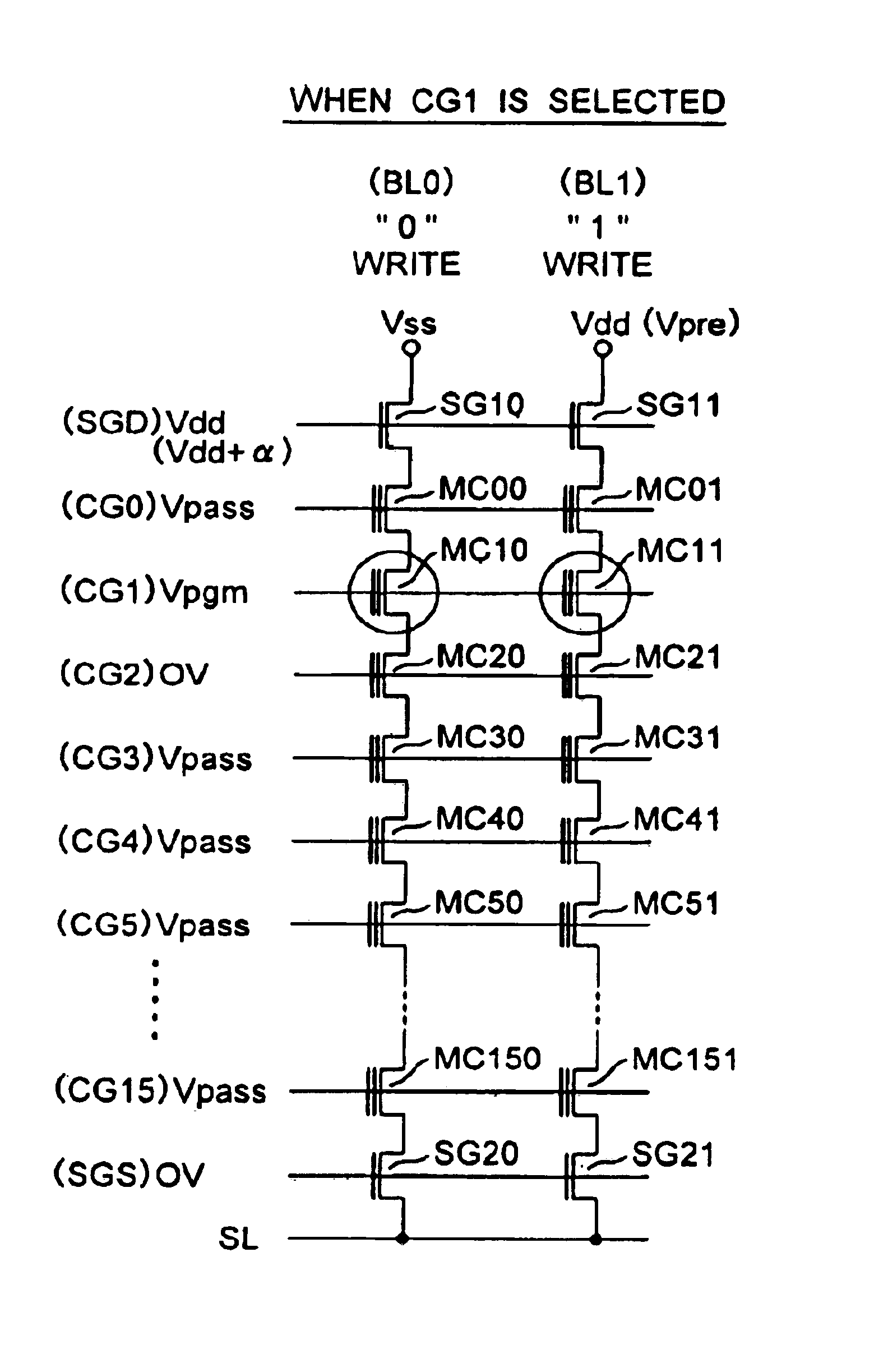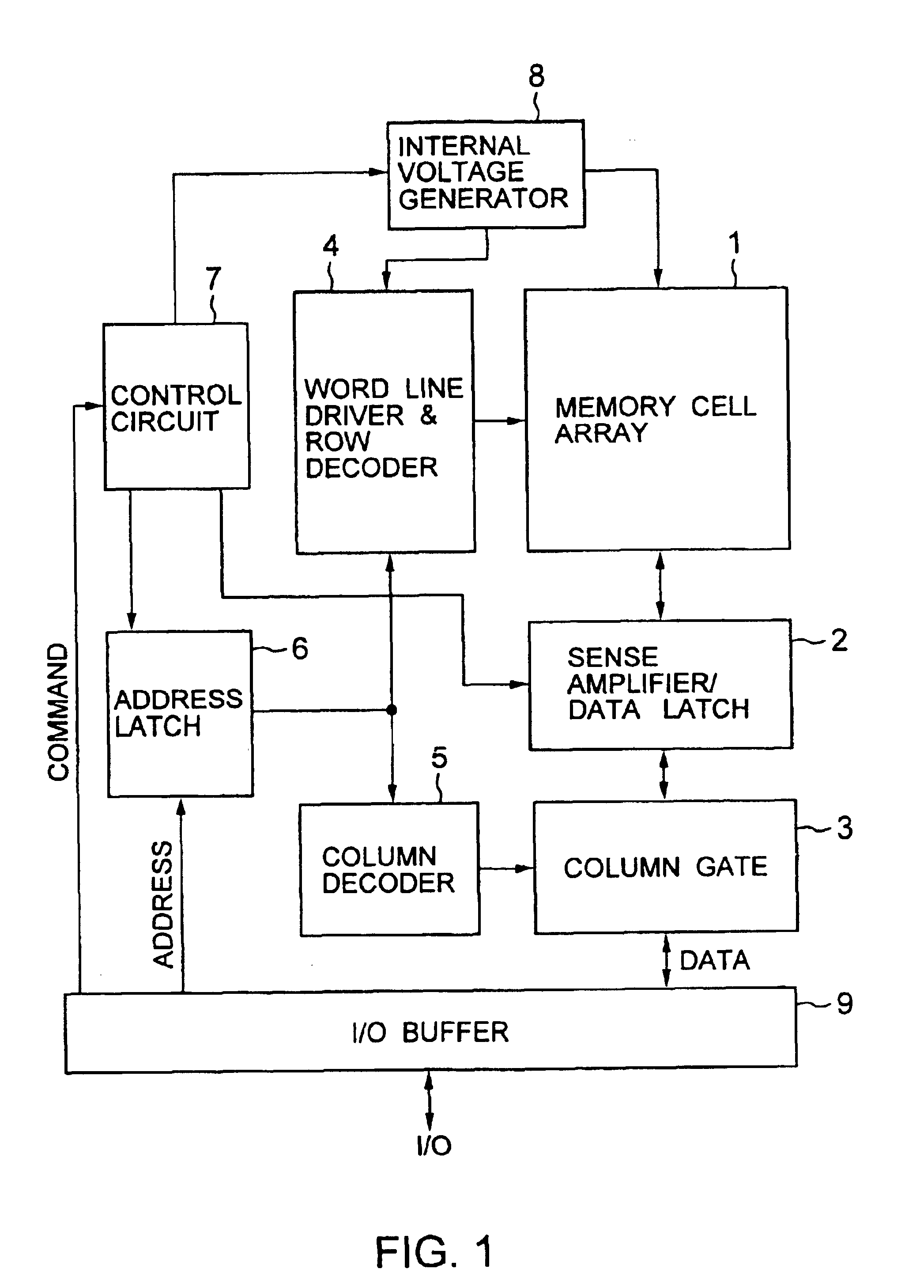NAND type non-volatile semiconductor memory device
a non-volatile, semiconductor technology, applied in the direction of transistors, digital storage, instruments, etc., can solve the problems of reducing affecting the efficiency of boosting efficiency, and difficulty in writing control
- Summary
- Abstract
- Description
- Claims
- Application Information
AI Technical Summary
Benefits of technology
Problems solved by technology
Method used
Image
Examples
embodiment 1
(Embodiment 1)
FIG. 3 shows a relationship among voltages applied to the NAND cells for two bit lines BL0 and BL1 when data is written to second memory transistor from the bit lines BL0 and BL1. FIG. 3 also shows that “0” and “1” data are given to the bit lines BL0 and BL1, respectively.
Before data writing, old data stored in the NAND cell block is erased collectively. Thus, all the memory transistors of the block are placed in an all- “1” state where the thresholds are low (for example, negative). Then, “0” or “1” write data is given from the sense amplifier / data latch 2 to the bit lines BL and written sequentially into the respective pages of memory transistors, starting with the page nearest to the common source line SL. At this time, before application of the write voltage, Vss=0 V and a boosted voltage Vpre higher than Vdd are given to the bit lines BL0 and BL1, respectively. At this time, by applying Vdd+α and Vss to the bit-line side select gate line SGD and the select gate li...
embodiment 2
(Embodiment 2)
In the above embodiment, one medium voltage Vpass was used. For example, in the example of FIG. 3, the medium voltage Vpass applied to the first control gate line CG0 when the second control gate line CG1 from the bit line was selected was an auxiliary voltage to boost as a unit the channel areas of the two memory transistors MC01 and MC11 on the “1” data writing side. For this reason, a specified medium voltage may be, for example, the power supply voltage Vdd or a higher appropriate value as the case may be. In this case, however, it is necessary to prevent no “0” data from being written into a non-selected memory transistor MC00 on the “0” writing bit line BL0 side. In this sense, the medium voltage should be lower than the writing voltage Vpgm.
In the example of FIG. 3, the medium voltage Vpass to be applied to the control gate lines CG3-CG15 through which the data writing was already performed is different in purpose from that applied to the control gate line CG0. ...
embodiment 3
(Embodiment 3)
In the previous embodiments, the conventional LSB system was basically used in which when “1” data is to be written, the channel of a memory transistor adjacent to the selected memory transistor is turned off. Only when a second memory transistor from each of the bit line and the common source line of the NAND cell were selected, the basic LSB system was modified.
In contrast, one embodiment in which the basic LSB system itself is modified will be described next. A write mode to be employed in this embodiment is based on the idea that when a control gate line in the NAND cell is selected, a memory transistor that cuts off its channel to boost the channel may not be a memory transistor adjacent to the selected memory transistor, but any two memory transistors between which the selected memory transistor is disposed may be used for that purpose. In this case, a medium voltage needs to be applied to the control gate lines of non-selected memory transistors disposed along w...
PUM
 Login to View More
Login to View More Abstract
Description
Claims
Application Information
 Login to View More
Login to View More - R&D
- Intellectual Property
- Life Sciences
- Materials
- Tech Scout
- Unparalleled Data Quality
- Higher Quality Content
- 60% Fewer Hallucinations
Browse by: Latest US Patents, China's latest patents, Technical Efficacy Thesaurus, Application Domain, Technology Topic, Popular Technical Reports.
© 2025 PatSnap. All rights reserved.Legal|Privacy policy|Modern Slavery Act Transparency Statement|Sitemap|About US| Contact US: help@patsnap.com



